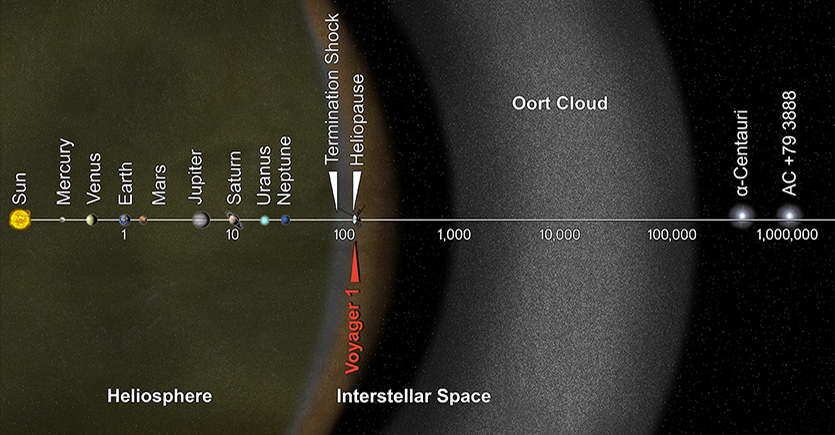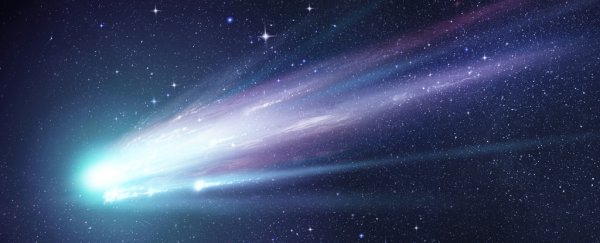By estimating the paths of several hundred thousand stars in the Milky Way galaxy, scientists have sketched out some back-of-the-envelope calculations on how likely it is that any could nudge a comet or two out of orbit and into our neighbourhood.
The bad news is there are around two dozen stars that could come close enough to stir up trouble. But don't worry, we're looking at a time scale of the next million years, so we can put comet strike down the bottom of the list of humanity's biggest concerns.
Researchers from the Max Planck Institute for Astronomy used data from the Gaia Space Telescope to track the orbits of around 320,000 stars as they slowly made their way around the Milky Way galaxy, and then predict which ones would come within a galactic whisper of our own Solar System.
Right now our Sun's closest stellar neighbour is Proxima Centauri, one of a trio of stars about 4.3 light years away.
That's hardly an easy rocket jump away, but in galactic scales that's still close enough for their gravity to gently pull on objects on the edge of our Solar System in a zone called the Oort cloud.
Not a lot of sunlight makes it out that far, so astronomers haven't actually seen this celestial backwater. Instead they assume its presence, since every now and then a piece of it veers out of its massive orbit and tumbles towards the Sun, streaming dust and gas in a long, iconic tail.
The Oort cloud is estimated to stretch from about 20,000 astronomical units (AU) to 100,000 AU, with a peak density at around the 40,000 AU mark.
Check out the handy diagram below to get a sense of perspective on this vast area.
 NASA
NASA
To keep track of this mix of star-scale units, just remember that 1 AU is roughly the distance from the Sun to the Earth, and 1 light year is a bit over 60,000 AU.
As the Milky Way slowly turns, stars move in their own orbits around the galactic centre, meaning Proxima Centauri won't hold its spot forever.
By the researchers' reckoning, within any one million year period between 490 and 600 stars will sit within 16.3 light-years of us, with many coming and going like traffic creeping along a celestial motorway.
Since the icy debris in our backyard is only loosely kept in place by the Sun's gravity, even that distance is enough to affect their orbits by the smallest degree, with passing stars potentially disturbing their orbits just enough to upset their stability.
The real concerns, however, could be the 19 to 24 stars that are expected to come within 3.26 light years, turning gentle nudges into more insistent pulls.
The closest shave will be from Gliese 710, a dwarf star that could actually barge straight through the Oort cloud itself in about 1.3 million years at an insanely close distance of 16,000 AU.
There is still plenty of wiggle room on these numbers, with more data needed to make predictions even more accurate. There are also speculations on encounters with shadowy stars we simply have no data on at all, such as a hypothetical dim twin of our own Sun called Nemesis.
None of these encounters are guaranteed to knock any comets into the inner Solar System, let alone promise any Earth-bound collisions. And unlike asteroid strikes, comets hitting any planet's atmosphere are extremely rare.
But if we're to do a risk assessment, the chances of a strike certainly do go up. And with recent research suggesting we've underestimated the number of massive comets out there, we should be paying close attention.
Unlike asteroids, comets tend to be loose aggregates of ice and rock. As they fall towards the Sun they tend to disintegrate, often leaving behind long trails of dust that are responsible for some of the more famous annual meteor storms.
Not all fractured comets could be so benign, however, with some larger objects potentially leaving a hazardous rain of meteorites in their wake.
With a comet being the most likely contender for the famous impact that contributed to the demise of most dinosaur species, keeping watch on the Solar System's outer limits could be considered as important as tracking the asteroids closer to home.
In fact, the research could be used in reverse, winding back the journey of the stars to see whether one might have been responsible for the cataclysmic dinosaur-ending event.
"Potentially you could imagine tracing the orbit back 66 million years and identifying whether there was any star that came close to the Sun and postulating whether that ejected a comet," researcher Coryn Bailer-Jones told Hannah Devlin at The Guardian.
This research was published in Astronomy & Astrophysics.
